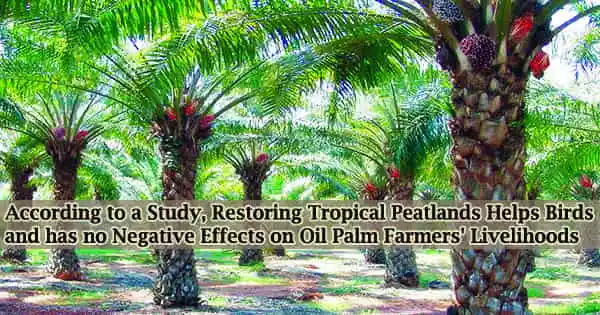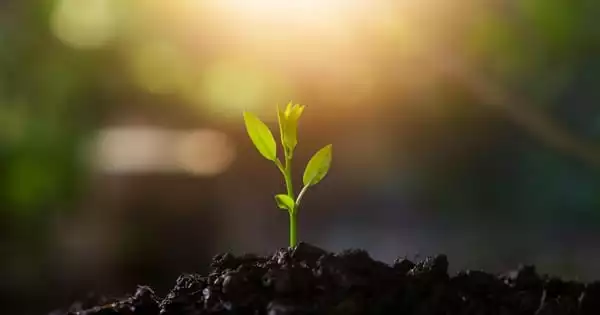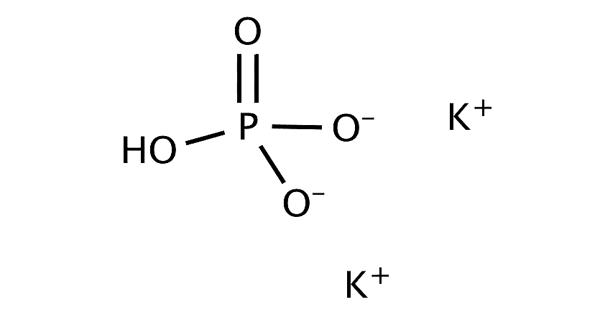According to a recent study, oil palm may be grown on peatlands more sustainably by rewetting the area, protecting both biodiversity and local livelihoods.
The study investigated whether regulating water levels on drained peatlands affects the viability of oil palm farmed by farmers as well as the diversity of bird species. It focused on tropical peatland restoration initiatives in Indonesia.
Large underground carbon reservoirs can be found in Southeast Asian tropical peatlands, whereas rare and endangered biodiversity can be found in peat swamp forests.
However, when peat bogs are cleaned and drained for farming, it causes land subsidence, biodiversity losses, and carbon emissions. The risk of fire in drained peatlands has in the past resulted in toxic smoke, fatalities, and financial and health harm.
According to estimates, Indonesia, primarily on the islands of Borneo and Sumatra, is home to 47% of the world’s tropical peatlands. In 1990, Sumatra’s peatland was 76% covered by forests; by 2015, it was 66% covered by smallholder agriculture or commercial oil palm plantations.
In order to preserve oil palm harvests, drainage is thought to be important because persistent flooding decreases fruit production. However, Sumatra is currently a hotspot for peat fires due to peatland drainage.
Rewetting should benefit smallholders by lowering the risk of fires that can harm property, plants, and people’s health, the study showed, with no discernible impact on oil palm production.
A farmer collaborating on the project, Mr. Udin, said: “Even if the farm flooded for a few days, the yield is not decreased.”
By also surveying bird species in one of the remaining peat swamp forest areas nearby, we also showed the huge importance of protecting the remaining forest for bird conservation avoiding fires in the landscape is key to doing this. These unique birds can also act as seed dispersers crucial if in the longer-term forest restoration becomes an option.
Dr. Eleanor Warren-Thomas
The study, published in the Journal of Applied Ecology, was led by the University of York and ZSL (Zoological Society of London), as well as colleagues from the Indonesian Center for Agricultural Land Resources Research and Development and Jambi University in Indonesia.
Water table depths were measured on oil palm farms run by smallholder farmers in the Jambi province of Sumatra, Indonesia, in order to evaluate the effects on oil palm production and the bird species that live on the fields.
Peat is a carbon-rich soil that develops from partially degraded vegetation under circumstances of constant moisture. In addition to providing habitat for tropical species, such as tigers, gibbons, birds, and highly suited plants, fish, and bacteria, tropical peatlands are crucial for storing carbon in the ground.
Peatlands are also used by small-scale oil palm producers to support their livelihoods.
To make the land suitable for cultivation, peatland must be drained using canals, which can have an adverse effect on habitats and cause the peat to emit carbon. Additionally, the dry ground may become more prone to fire, posing a risk to both human and animal lives as well as increasing carbon emissions and poisonous smog.
A procedure known as “rewetting” is used to restore drained peatland, which prevents peatlands from catching fire by blocking or filling in canals that drain water away.
Only 48 bird species were discovered in oil palm, compared to 90 bird species in a nearby peat swamp forest. For this reason, protecting forests is essential for preserving biodiversity. The species that live in forests are also diverse, with 35 of them being conservation priorities. They also tend to be larger-bodied species that perform varied ecological tasks.
Rewetting oil palm farms close by should lower the risk of forest fires and subsequent habitat loss for wildlife while maintaining support for farmer output.
Dr. Eleanor Warren-Thomas, now at Bangor University and IIASA, and who led the study while a researcher at York, said:
“Indonesia has been very successful in reducing deforestation and considerable effort has gone into peat restoration to avoid fires. But one of the big challenges is the trade-off between livelihoods of owners of small farms and ensuring biodiversity in these areas.”
“What this new study shows is that retaining more water in oil palm farms to reduce fire risk seems to have no effect on yields, which is good news for farmers. In contrast to the concerns of some plantations, retaining water levels close to the surface (40cm or less) still enables oil palm cultivation.”
Eleanor said: “By also surveying bird species in one of the remaining peat swamp forest areas nearby, we also showed the huge importance of protecting the remaining forest for bird conservation avoiding fires in the landscape is key to doing this. These unique birds can also act as seed dispersers crucial if in the longer-term forest restoration becomes an option.”
“One of the conclusions of the study is that larger-scale industrial farming organizations would be able to help further studies in this area if they are able to publish their data and share their knowledge to inform sustainable oil palm production strategies.”
















